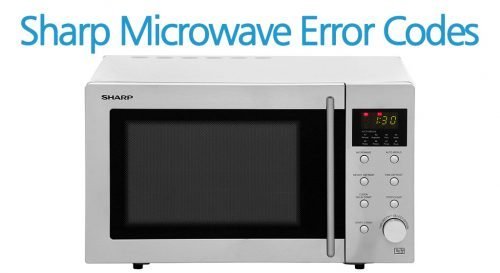
You see, microwaves, much like other modern appliances, come equipped with error codes to communicate issues that may arise internally. Think of it like your car’s dashboard, which lights up when it’s time for maintenance. An error code is essentially your microwave’s way of saying, “Hey, something isn’t quite right here!” For Sharp microwaves, specifically, error code E1 typically points to a problem with the microwave’s sensor, and knowing what this means can help you get back to heating up your leftovers in no time.
Understanding the E1 Error Code on Sharp Microwaves
The E1 error code can feel like a mysterious message from your microwave. In simple terms, this code usually points to a sensor issue. You might be thinking, “What’s a sensor, anyway?” Well, in the context of a microwave, a sensor is like the eyes and ears of the appliance. It helps detect and adjust the cooking process to ensure your food is heated evenly.
Imagine you’re baking a cake, and you have a timer and a thermometer to check if it’s done. The sensor in your microwave plays a similar role but for reheating or cooking food. When the sensor isn’t working properly, your microwave can’t accurately measure temperature or humidity levels, which can lead to improperly cooked meals. The E1 code is your microwave’s way of alerting you that this vital component needs attention.
So, why does this happen? There could be several reasons behind a faulty sensor. It might be a case of dirt or food particles blocking the sensor, or the sensor might be malfunctioning due to wear and tear over time. Whatever the cause, addressing it will help you get back to efficient microwave use.
How to Troubleshoot an E1 Error Code
Now that you understand what the E1 error code signifies, let’s delve into how you can troubleshoot this problem. First off, don’t panic. There are a few straightforward steps you can try before calling in a professional.
Step one is cleaning. Just like how dust accumulates on your windowsill, food particles can build up in your microwave. Open the microwave and carefully clean the interior, paying special attention to the sensor area. This is often located on the interior right side. Use a damp cloth or sponge, and ensure no residue is left behind.
If cleaning doesn’t resolve the issue, a reset could do the trick. Think of a reset as a nap for your microwave to refresh its sensor operations. Unplug the microwave for a couple of minutes, then plug it back in. This resets the internal settings and could clear the error code if it was a minor glitch.
If neither of these steps works, it might be time to seek professional help. An appliance technician can diagnose the issue more thoroughly and potentially replace faulty components. While it might sound daunting, trust me, getting a professional to look at it could save you from future headaches.
Preventing Future E1 Errors
It’s always best to prevent problems before they start, right? Luckily, there are a few simple habits you can adopt to minimize the chances of encountering the E1 error code in the future.
Regular cleaning is your first line of defense. Make it a routine to wipe down the interior of your microwave weekly. This not only keeps your appliance in top shape but also ensures sensors remain unobstructed.
Another tip is to avoid overloading your microwave. Placing too much food inside or using inappropriate containers can cause food spills or splatters, which might affect the sensor’s accuracy. Stick to manufacturer guidelines regarding load sizes to keep everything running smoothly.
Finally, treat your microwave with care. Like any other appliance, it benefits from gentle handling. Avoid slamming the door or engaging it with forceful actions. These small adjustments to your usage can extend the life of your microwave and keep pesky error codes at bay.
In conclusion, while encountering an E1 error code on your Sharp microwave can be frustrating, it’s manageable with a little understanding and care. By recognizing the issue, trying out simple troubleshooting steps, and adopting some preventive measures, you can enjoy hassle-free microwave cooking once again. So next time you see that E1 flashing, you’ll know exactly what to do!